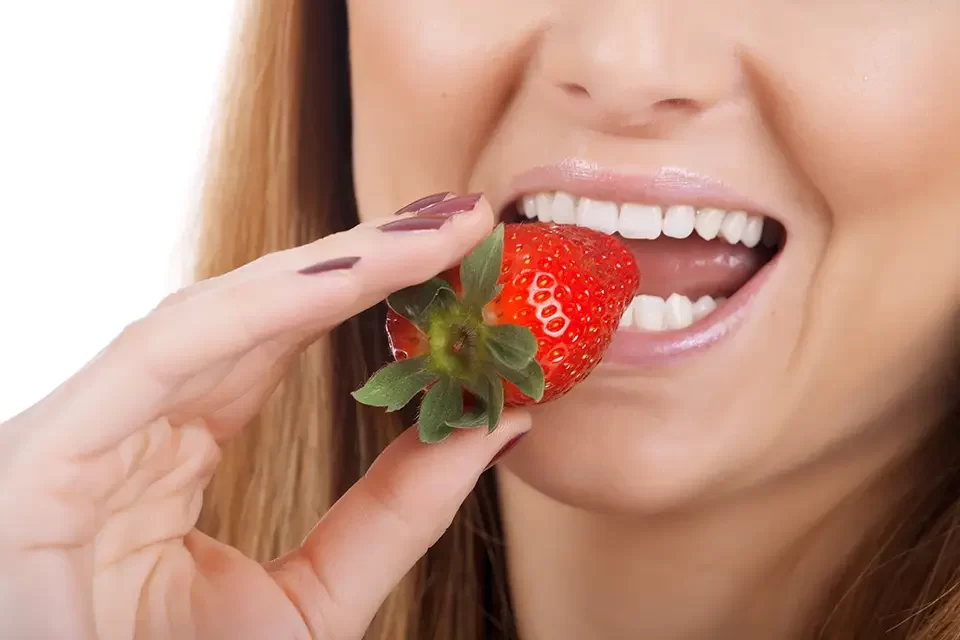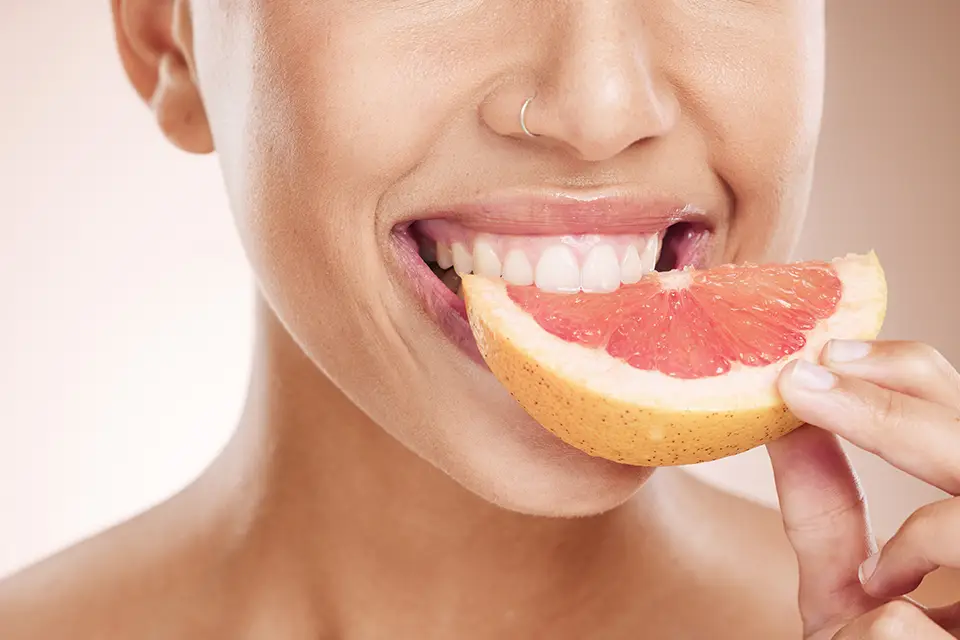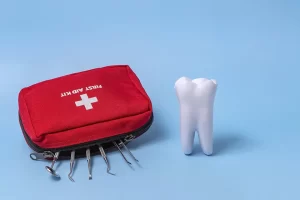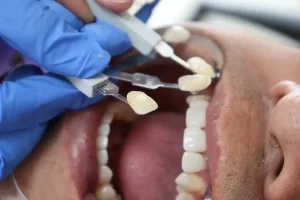If your smile looks a shade darker than you remember, start with habits that are easy to keep. Professional whitening lifts deep stains, but day-to-day choices keep that brightness around. That’s where foods that whiten teeth naturally come in. Used thoughtfully, foods that whiten teeth naturally help clear soft plaque, buffer acids, and support enamel so colour doesn’t fade between cleanings. At FIFTH ST Dental in Etobicoke, we like simple, sustainable steps—things you can do at breakfast, lunch, and the drive home from work.
How Food Helps (Without Replacing Care)
Food won’t “bleach” enamel. What it can do is (1) stimulate saliva to rinse pigments, (2) provide minerals that strengthen enamel, and (3) gently disrupt the film that holds stains. That’s enough to slow new discolouration and keep professional results longer.
The Top 10: Foods That Whiten Teeth Naturally—and Why They Work
1) Apple — Crisp Fibres, Real Saliva Flow
An apple’s crunch dislodges soft plaque while the high water content dilutes acids. Eat it as a mid-afternoon reset, then sip water. You get the fresh “polished” feel without reaching for a brush at your desk.
2) Strawberry — A Touch of Malic Acid
Strawberries contain malic acid that can loosen superficial stains. Keep it simple: eat the berry, don’t mash it into DIY pastes (too acidic, too concentrated). Pair with a glass of water or a spoon of plain yogurt to balance pH.
3) Pineapple — Enzymes That Break Up Film
Bromelain, a natural enzyme, helps disrupt the protein layer that grabs pigments. A few chunks with lunch are enough. If you have sensitivity, keep portions modest and follow with water.
4) Leafy Greens (Spinach, Kale) — A Quiet Shield
Greens encourage saliva and can leave a micro-film that reduces how strongly pigments attach. A small salad before coffee, tea, or tomato sauce is a smart buffer you’ll barely notice.
5) Carrots & Celery — Everyday "Scrubbers"
Their fibrous texture knocks back soft buildup and seeds saliva. Keep sticks in the fridge; ten chews do more than you’d think. If you’re building a list of foods that whiten teeth naturally, these are easy wins.

6) Cheese — Minerals and pH Balance
A small cube after meals raises pH and delivers calcium and casein—both support remineralization. That stronger enamel surface resists stains and abrasion better.
7) Plain Yogurt — Minerals, Little Sugar
Calcium and phosphate help repair early mineral loss. Choose plain; add berries or a pear for flavour and water content. It’s a reliable anchor for foods that whiten teeth naturally in the morning.
8) Nuts & Seeds (Almonds, Sesame) — Saliva and Gentle Abrasion
Chewing stimulates saliva; fine particles lightly “polish” surfaces. Choose unsalted to be kind to gums. If a flake lingers, a quick water rinse finishes the job.
9) Pear — Hydration That Dilutes Acids
Pears are mostly water, slightly sweet, and less acidic than many fruits. They help flush pigments while you eat. Follow with a sip of water, and you’re done.
10) Green Tea & Water — Small Sips, Big Impact
Water clears pigments between bites and sips. Unsweetened green tea may reduce bacterial adherence. Think of beverages as part of foods that whiten teeth naturally—because they absolutely influence colour over time.
Put Them to Work: Simple, Real-Life Pairings
- Breakfast: Plain yogurt + strawberries + chopped almonds. Minerals, gentle stain-lifting, saliva—three boxes ticked.
- Lunch starter: Small spinach salad before pasta or curry; you’ll buffer acids before pigments arrive.
- Snack: Apple or carrot sticks with water. Easy, portable, and helpful on busy days.
- After dinner: One bite of cheese to raise pH, then water. A two-minute routine that pays off.
These pairings turn a list of foods that whiten teeth naturally into habits you barely have to think about.
More: What to Do in a Dental Emergency
Foods That Whiten Teeth Naturally: What To Limit
You don’t need to avoid favourites; just control contact time.
- Deep-coloured drinks: Coffee, black tea, red wine. Use a straw for iced versions, sip water alongside, and avoid long “nursing.”
- Acidic sauces: Tomato and soy-based sauces soften enamel briefly. Balance with greens or a small dairy portion.
- Sticky sweets: Pigments cling longer. Rinse with water after, then brush 30 minutes later (not right away on softened enamel).
A few small offsets keep foods that whiten teeth naturally in the driver’s seat.
Routine That Protects Your Shade (Under Five Minutes Daily)
- Morning: Brush with a fluoride paste; finish with water or unsweetened green tea.
- Midday: Add one crunchy item (apple, carrots) and water.
- Evening: Floss, brush, and skip dark beverages late at night.
- Weekly: Plan yogurt, cheese, and greens into meals. Repetition matters more than perfection.

Foods That Whiten Teeth Naturally: Where Diet Fits with Professional Care
Diet supports; dental care restores. At FIFTH ST Dental, we pair foods that whiten teeth naturally with:
- Hygiene visits to remove tartar and polish what home care can’t.
- Whitening plans (in-office or trays) for deeper stains, then diet to maintain shade.
- Sensitivity support (fluoride varnish, desensitizing pastes) when needed, so brightening doesn’t mean discomfort.
If staining is internal (from trauma, some medications), food won’t change colour much; we’ll advise on the right route.
The Bottom Line
Small, repeatable choices are what keep a smile bright. Add a few of these ten options each day, trim the contact time for the biggest stainers, and keep up with cleanings. If you want a plan that fits your diet, your schedule, and your enamel, book a visit with FIFTH ST Dental in Etobicoke. We’ll check what’s causing the colour change, suggest the right treatment—if you need one—and show you how to use food to protect the shade you like.
FAQs — Foods That Whiten Teeth Naturally
Do these foods replace whitening?
No. They help prevent and slow stains, and they make professional results last longer. Think prevention and maintenance—not bleaching.
How fast will I notice a difference?
Expect a “cleaner” look within a few weeks if you’re consistent and cut down contact time with dark drinks. Real change builds quietly and sticks.
Are acidic fruits risky for enamel?
In large, frequent amounts—yes. Keep portions sensible, pair with dairy or greens, and wait 30 minutes before brushing. That way, foods that whiten teeth naturally stay helpful, not harsh.
Which is better: green tea or coffee?
For colour, green tea is gentler. If you love coffee, drink it in a shorter window, rinse with water, and use a straw for iced versions.
My teeth still look dull—what next?
Diet can’t lift deep stains. A cleaning and a tailored whitening plan will. We’ll map out options and keep foods that whiten teeth naturally in your routine so results hold.





